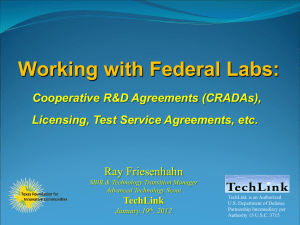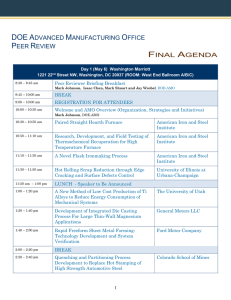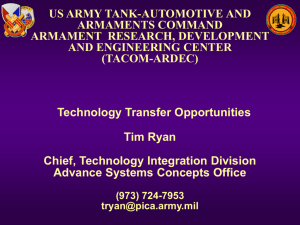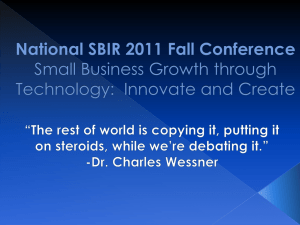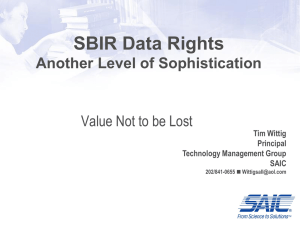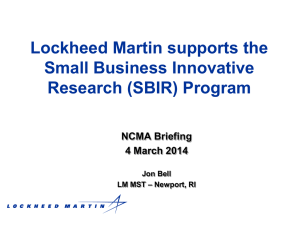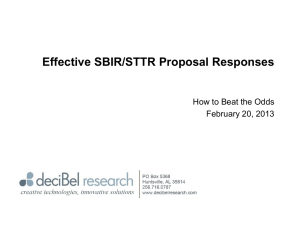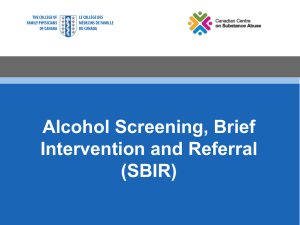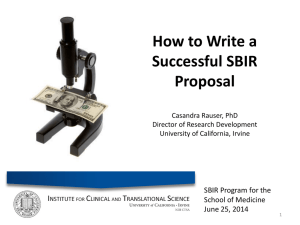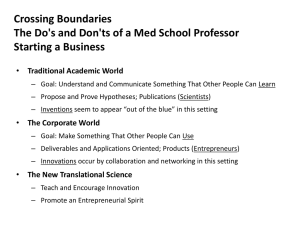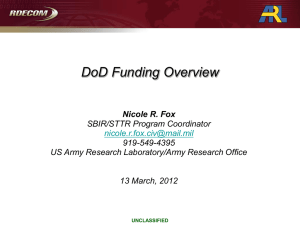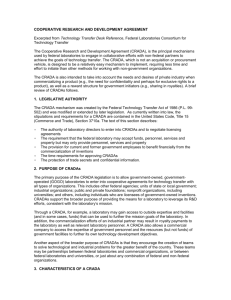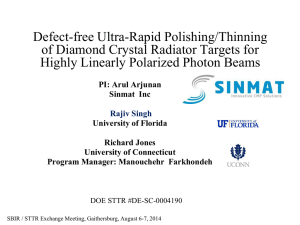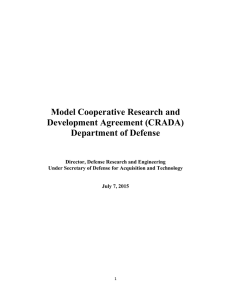Ray Friesenhahn, Senior Technology Manager, TechLink
advertisement
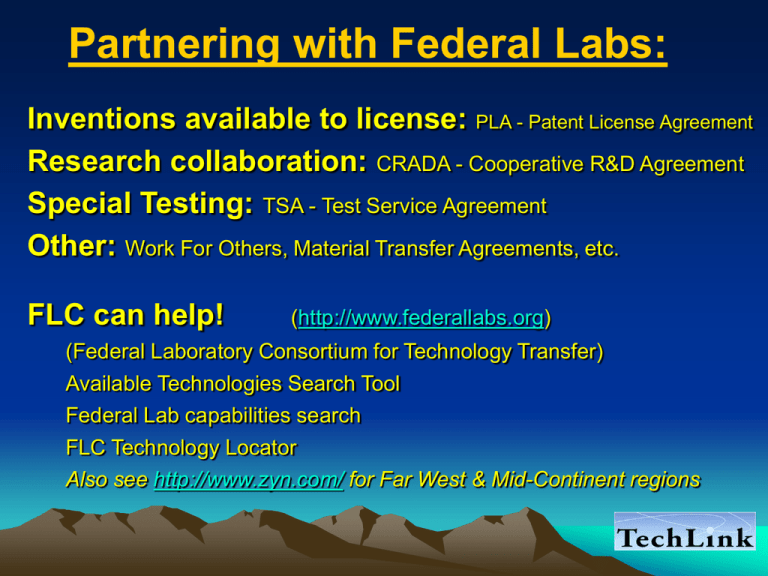
Partnering with Federal Labs: Inventions available to license: PLA - Patent License Agreement Research collaboration: CRADA - Cooperative R&D Agreement Special Testing: TSA - Test Service Agreement Other: Work For Others, Material Transfer Agreements, etc. FLC can help! (http://www.federallabs.org) (Federal Laboratory Consortium for Technology Transfer) Available Technologies Search Tool Federal Lab capabilities search FLC Technology Locator Also see http://www.zyn.com/ for Far West & Mid-Continent regions Partnering with Federal Labs: Advantages of a CRADA (Cooperative R&D Agreement): • Tie into significant R&D capability at little or no cost • Utilize specific R&D capability available nowhere else • Increase your perceived credibility based on partnership • Become familiar with Agency (customer) needs, culture • Agency personnel become familiar with your capabilities for potential advantages • Often opens doors for other funding opportunities • SBIR/STTR plus the OTHER 96% - tremendous long-term value! Note: federal law prohibits payment to company under a CRADA, while companies may pay lab for services, which may now be allowed as an SBIR/STTR subcontract. One Client’s Perspective: “Especially, I would like to thank Ray for his suggestion to put in place a CRADA with DMEA. Daniel ** from DMEA was well connected with the Air Force decision makers and gave [us] very valuable guidance that helped us focus our efforts on what the Air Force wanted to see. I believe this relationship played an important role in our [Air Force SBIR Phase II] win.” - TechLink client company with ~40 SBIR/STTR awards, 4/5/13 TechLink Primary Defense-wide Partnership Intermediary for technology transfer & transition • • • • Facilitates ~60% of all DoD Patent License Agreements (PLAs) Assists DoD CRADAs, TSAs, etc. (regionally, or synergistically) Over 1200 technology partnerships (>850 DoD partnerships) 2012 independent economic impact assessment (2000 – 2011): • $2.935 Billion total ($1.033 Billion direct); 17,818 jobs Nationwide DoD SBIR support • Phase II, Phase III & Transition for selected client companies • Additional SBIR support (any agency) for Montana companies & startups, and members of the Advanced Power & Energy Cluster (APC) Client Example: Visual Learning Systems, Inc. Transition Success: Feature AnalystTM Software Technology: Software for automated feature extraction in hyperspectral or panchromatic images. Learning algorithms are orders of magnitude faster than manual digitizing, also easy to train. • Developed under multiple SBIRs: • 3 NASA SBIR awards, 3 NSF • Army TEC Ph. I & II, NAVAIR Ph. I & II • CRADAs & Partnerships with Gov’t: • Army TEC & NUWC CRADAs • NASA TCA • NIMA & NRO partnerships • Partnered with Primes: • ESRI, Leica, BAE, Intergraph Chosen by NGA for deployment across all NGA’s Integrated Exploitation Capability (IEC) workstations – Now Dual-Use (Commercial & Military) Success! Timeline: Feature Analyst Transition NASA Stennis Phase II TCA with NASA JPL NASA Stennis Phase I 1998 NASA JPL Phase I NRO Fastmax NIMA “Big Ideas” 1999 2000 Army TEC Phase I award NUWC CRADA Army TEC CRADA NIMA BAA 2001 NRL contract 2002 USFS Testing New Company: Visual Learning Systems Company: Integrated Geosciences Army TEC Phase II award ESRI partnership Feature Analyst for ArcGIS 2003 NSF Phase II 2004 NAVAIR Phase I award NAVAIR Phase II award Army TEC Phase I award 2005 BAE Systems partnership Army TEC Phase II award Textron Overwatch Acquisition Acquisition $325M FA for SOCET SET Leica Geosystems partnership FA for ERDAS NGA Product Adoption (Integrated Exploitation Capability) CRADA after SBIR: Compounds for Infection Prevention Objective: To improve healing of wounded warfighters through the use of new antiinfective antibiofilm compounds. Benefits: Fewer wound infections and faster recovery, with reductions in mortality, hospitalization, and long-term impairment. Participants: • U.S. Army Inst. of Surgical Research (USAISR) • Microbion Corp. (Bozeman, MT) • TechLink Status: • Microbion moved to Bozeman in 2005 for closer collaboration with MSU CBE, partner in an NIH Phase I SBIR. This CRADA for Dev. of Military/Field Hospital Therapeutic Antiinfective, Antibiofilm Acute Wound Care Gel Product led to major contracts. Technology: Company’s new BismuthThiol (BT) compounds disrupt the formation of bacterial biofilms and allow significantly improved wound treatment. Biofilm formation increases the antibiotic resistance of infectious bacteria, making treatment much more difficult. Bacterial biofilm growth in wounds (left) complicates medical treatment Company’s CRADA Results Research contract award from Orthopaedic Trauma Research Program (OTRP) $500K/year, for up to 5 years, some testing by USAISR Partnership in AFIRM Consortium Armed Forces Institute of Regenerative Medicine: two consortia will develop better treatments for seriously injured warfighters in $250 million program. Additional major funding opportunities secured. Scientific Materials • SMC focused on adv. laser crystal growth • Developed via 30 SBIR/STTR awards ’89 – ’04 • Very close university (MSU) collaboration • SMC participant in $1M ManTech project • SMC cost share $566K in 2000 – 2001 project • Monoblock laser enabled by adv. laser xtals • TechLink assisted license application • Submitted April 2001, signed April 2003 • MilTech (MEP) aided design, production • Shock-resistant adhesive bonding • Manufacturing/production scale-up • SMC sold to FLIR Systems (2005) for $13M • • • • Purchased solely for monoblock capabilities Over 7,000 units produced, 60 empl. locally Primary application is STORM (2-6 km range) Larger unit in FLIR Star SAFIRE III (25 km range) - >500 units sold Fielded Applications: FLIR Systems AN/AAQ-22 Star SAFIRE III UH-60 Blackhawk MQ-8B Fire Scout AN/PSQ-23 STORM-mLRF (Small Tactical Optical Rifle Mounted Micro-Laser Range Finder) MQ-1 Predator Aerostat and Tower Ground Surveillance Common Remotely Operated Weapon Station (CROWS) II Stryker Remote Weapon Station STORM-mLRF Contract • June 2011: 5-yr IDIQ contracts issued for AN/PSQ-23 STORM-mLRF • DRS Technologies Reconnaissance, Surveillance and Target Acquisition (RSTA) Group: up to $514.3 million for 150 – 32,000 STORM-mLRF units • L-3 Warrior Systems Division (Insight Tech): up to $438.8 million for 150 – 32,000 units • STORM used on M16/M4 light weapons, M240/M249 machine guns, M107/M110 sniper rifles, Stryker vehicle, light artillery, CROWS II, etc. • SMC is only manufacturer of Monoblock Laser used in STORM-mLRF
